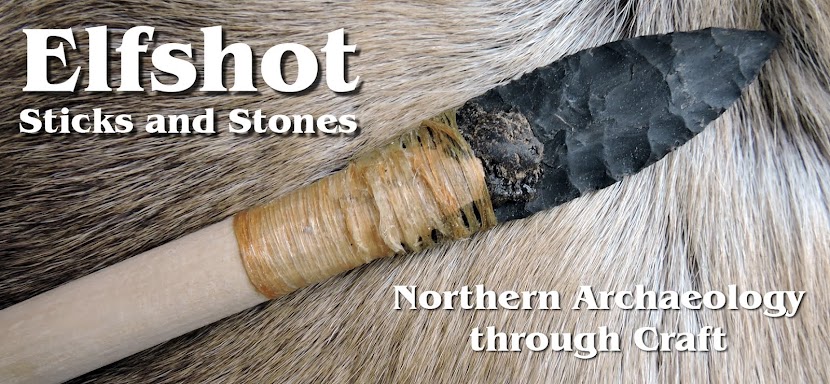 |
| Completed adze, scraper, and knife |
The L'Anse aux Meadows reproductions are finished now and I'm just waiting for the sealskin binding on the adze to dry before sending it all off. The original adze head that the reproduction is based on is being driven to L'Anse aux Meadows at the moment so I darted in yesterday morning for one last side-by-side comparison before it was packed up and escorted away.
 |
| Adze reproduction and artifact |
Palaeoeskimo Adze: An adze is a wood working tool with its head mounted at right angles to the handle, looking kind of like a hoe instead of an axe. None of the organic components of the artifact were preserved, I just had the ground stone bit to start from. An axe will be symmetrical, with the blade aligned in the middle of the head, while an adze will usually be sharpened so that the bit is closer to one face or the other. This one was made on a large flake of tough (perhaps silicified) slate. Most of the dorsal surface of the adze head was completely ground and polished, so the only remnant of the original flake is on the ventral surface. The most distinctive feature of the adze head is the isolated stem opposite the bit end. That provides an important clue for how it would have been hafted.
 |
| Note the stem on the artifact |
The Maritime Archaic adzes that we find tend to be relatively long and narrow, without a contracting stem. At Palaeoeskimo sites (especially Groswater Palaeoeskimo sites) in the province, we find shorter, wider adzes with a contracting stem designed to fit into an antler socket. The L'Anse aux Meadows adze is the largest adze of this kind that I've seen, so its tempting to associate it with the Maritime Archaic culture, because they were known for their large ground stone tools. However, every feature of its construction - especially the stem, suggest a Palaeoeskimo and probably Groswater Palaeoeskimo origin. I think its the biggest Groswater Palaeoeskimo adze in the world.
 |
| Giant Palaeoeskimo adze, small Maritime Archaic Adze |
I'm not aware of any antler sockets from Groswater sites, but caribou antler adze sockets are a common artifact in Palaeoeskimo sites across the North, including Dorset sites in Newfoundland. I think they are pretty clever. The antler acts as a shock absorber that probably helps extend the life of the tool and I'd guess it might help with hand shock on the user, but I couldn't say for sure. It also allows smaller bits of stone to be used. In the earlier, one-piece Maritime Archaic Adzes half of the adze head is used for cutting and the other half of the adze head is used for hafting. The antler socket divides that job up so that the stone adze bit can focus on cutting and the antler takes care of the hafting. Using the socketed design, you can do the same job but with a stone half the size.
 |
| The antler socket will be lashed to the handle |
I didn't have a piece of antler that fit the adze without bending, so I had to soak the antler in vinegar for a couple of days and slowly wedge it open wide enough to accept the adze head. This created a very secure fit. Its important that the adze is firmly mounted in the spongy antler in the middle of the antler, you don't want to cut through the dense antler around the edges or the antler will crack in use. The natural flare of the antler is used to create the V-shaped socket. The narrow end of the adze sockets are modified for hafting and the artifacts from Port au Choix that I used as references for this reproduction tend to have flat blunt ends, so I think they were designed to butt up against a wood shelf in the handle.
 |
| Tamarack handle, caribou antler socket, slate adze |
The handle is tamarack and I did a lot of research trying to find Palaeoeskimo adze handles for references, but they are pretty scarce. I based this one on an artifact from a Baffin Island Dorset Site. The biggest difference between this reproduction and the artifact was that the artifact adze handle was a simple "L" shape, without the raised back at the top for the butt of the antler socket to rest against. I'm not done thinking about adzes - if anyone knows of any other Palaeoeskimo adze handles, I'd love to hear from you.
 |
| Comparing the bit edge |
The handle is made from a fork in a tree branch, which is trick used by adze makers around the world to create a strong "L" shaped bend in their handles. The wood shelf that the antler is tied to is just a mirror image of the hafting area of the socket. I'm satisfied that it looks like a Palaeoeskimo haft. The binding is the sealskin from the hooded seal that we prepared this spring. I'm very happy with how it turned out. That black air-dried look is exactly what I wanted on my reproductions. I'll talk more about working with the sealskin in a future post, but so far all of the lashing that I've used have come from cutting the shaved sealskin in half down the middle. Which means that the 335 feet of skin could yield 670 feet of useable lashing.
On Friday, I'll show you the finished Groswater Palaeoeskimo harpoon.
Photo Credits: Tim Rast






















































